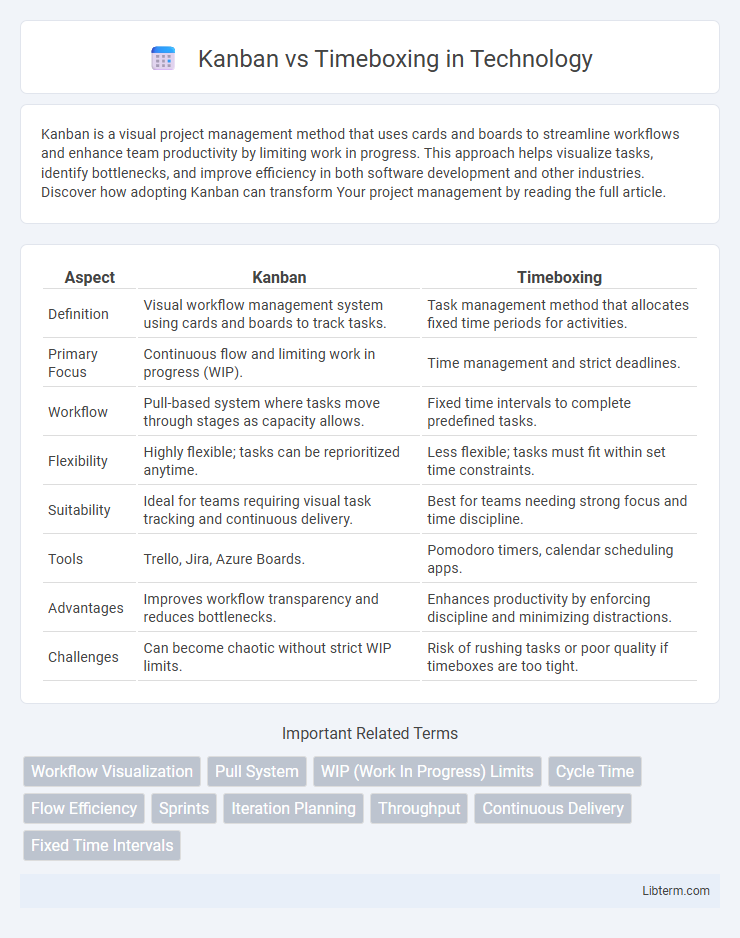Kanban is a visual project management method that uses cards and boards to streamline workflows and enhance team productivity by limiting work in progress. This approach helps visualize tasks, identify bottlenecks, and improve efficiency in both software development and other industries. Discover how adopting Kanban can transform Your project management by reading the full article.
Table of Comparison
| Aspect | Kanban | Timeboxing |
|---|---|---|
| Definition | Visual workflow management system using cards and boards to track tasks. | Task management method that allocates fixed time periods for activities. |
| Primary Focus | Continuous flow and limiting work in progress (WIP). | Time management and strict deadlines. |
| Workflow | Pull-based system where tasks move through stages as capacity allows. | Fixed time intervals to complete predefined tasks. |
| Flexibility | Highly flexible; tasks can be reprioritized anytime. | Less flexible; tasks must fit within set time constraints. |
| Suitability | Ideal for teams requiring visual task tracking and continuous delivery. | Best for teams needing strong focus and time discipline. |
| Tools | Trello, Jira, Azure Boards. | Pomodoro timers, calendar scheduling apps. |
| Advantages | Improves workflow transparency and reduces bottlenecks. | Enhances productivity by enforcing discipline and minimizing distractions. |
| Challenges | Can become chaotic without strict WIP limits. | Risk of rushing tasks or poor quality if timeboxes are too tight. |
Introduction to Kanban and Timeboxing
Kanban is a visual workflow management method that uses boards and cards to track tasks, enhancing transparency and continuous delivery. Timeboxing is a project management technique that allocates fixed time periods for activities, promoting focus and preventing scope creep. Both methods improve productivity by encouraging structured task management and efficient time use.
Core Principles of Kanban
Kanban's core principles emphasize visualizing work through a workflow board, limiting work in progress (WIP) to enhance focus and reduce bottlenecks, and managing flow by continuously monitoring and adjusting tasks to optimize delivery speed and quality. Timeboxing, in contrast, divides work into fixed time intervals called sprints or iterations, focusing on delivering predetermined outputs within set time limits. By prioritizing transparency and continuous improvement, Kanban fosters flexibility and adaptability in workflow management, unlike the rigid time constraints emphasized in Timeboxing.
Core Principles of Timeboxing
Timeboxing centers on allocating fixed, predetermined periods to tasks, promoting focused work and preventing scope creep. It emphasizes strict time limits to enhance productivity, encourage quick decision-making, and enable regular assessment of progress. This approach contrasts with Kanban's continuous flow by prioritizing time-bound iterations for structured task completion.
Key Differences Between Kanban and Timeboxing
Kanban uses a continuous flow approach with visual boards to manage work items, emphasizing work-in-progress limits and task prioritization, whereas Timeboxing structures work into fixed, predetermined time intervals to enhance focus and deadline adherence. Kanban offers flexibility by allowing tasks to be pulled as capacity allows, while Timeboxing enforces strict time boundaries to boost productivity and limit distractions. The key difference lies in Kanban's adaptive workflow versus Timeboxing's rigid, time-focused scheduling methodology.
Advantages of Using Kanban
Kanban offers a flexible workflow visualization that enhances task prioritization and real-time progress tracking, leading to increased team efficiency. The method promotes continuous delivery without fixed time constraints, allowing for better adaptability to changing project requirements. Kanban's focus on work-in-progress limits reduces bottlenecks and improves overall productivity by maintaining a smooth task flow.
Benefits of Timeboxing in Project Management
Timeboxing enhances project management by setting fixed time periods for tasks, which boosts focus and reduces procrastination. It improves deadline adherence and resource allocation, ensuring efficient progress tracking and timely delivery. This method also fosters better team discipline and prioritization, leading to increased productivity and project control.
When to Choose Kanban Over Timeboxing
Choose Kanban over Timeboxing when work requires continuous delivery and flexible prioritization, especially in projects with variable task sizes and unpredictable workflows. Kanban's visual boards and WIP (Work In Progress) limits optimize flow and minimize bottlenecks, making it ideal for maintenance, support, or operational environments. Teams facing frequent interruptions or evolving requirements benefit from Kanban's adaptability, whereas Timeboxing suits fixed-scope, deadline-driven tasks.
When Timeboxing Works Better Than Kanban
Timeboxing works better than Kanban when strict deadlines and fixed time intervals are essential to managing tasks, promoting a sense of urgency and focused productivity. It is ideal for projects requiring regular progress reviews, such as sprint planning in Agile frameworks, where predefined time limits enhance discipline and prevent scope creep. Timeboxing provides clear commitment boundaries that help teams allocate resources efficiently and maintain consistent delivery rhythms.
Common Challenges with Kanban and Timeboxing
Common challenges with Kanban include managing workflow bottlenecks and maintaining clear prioritization as tasks continuously flow without fixed deadlines. Timeboxing faces difficulties in accurate estimation and rigid adherence to time limits, which can lead to compromised quality or rushed outputs. Both methods require careful balance between flexibility and discipline to ensure productivity and project goals alignment.
Conclusion: Selecting the Right Approach
Kanban optimizes workflow through continuous delivery and flexible prioritization, making it ideal for teams requiring adaptability and real-time process visualization. Timeboxing establishes fixed periods to promote focus and enforce deadlines, benefiting projects with strict schedules and clearly defined deliverables. Selecting the right approach depends on the team's need for flexibility versus deadline discipline, project complexity, and the importance of incremental progress tracking.
Kanban Infographic

 libterm.com
libterm.com